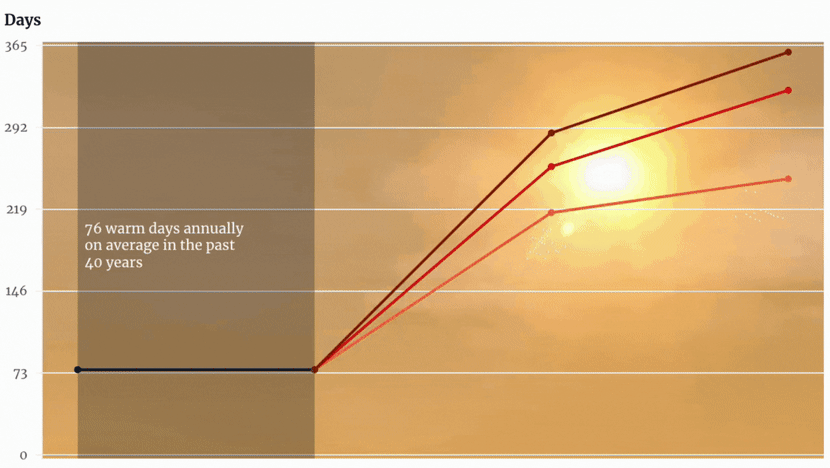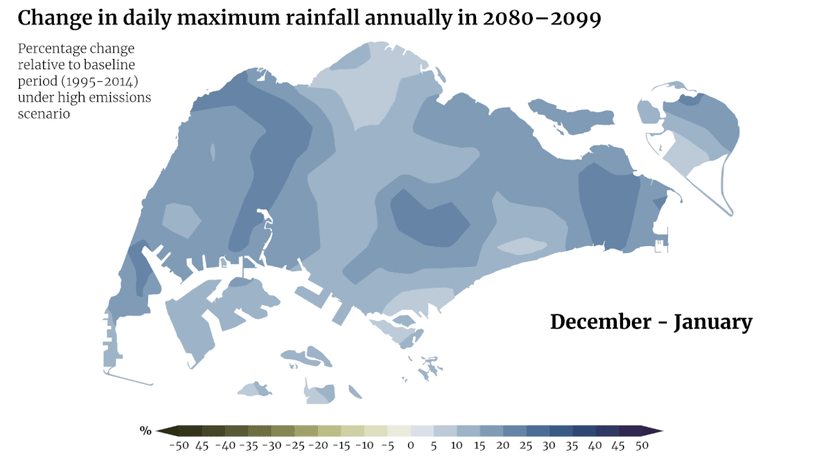Scaremongering tactics again. If we get colder days instead 3 to 4 decades later or with no significant increase in heat days like what happened to Ai Gore's famous failed prediction and countless others for the past 5 decades, these farkers will never take responsibility for their errors.
https://www.channelnewsasia.com/singapore/how-singapore-climate-could-change-charts-4026486
Here's how much hotter, wetter and drier Singapore will get by the end of this century, according to new projections by the meteorological service.

These charts show how much hotter, wetter and drier Singapore will get by the end of this century, according to new projections by the meteorological service. (Charts: CNA/Clara Ho)
06 Jan 2024 06:00AM
SINGAPORE: If there’s one key takeaway from Singapore’s latest national climate change study, it would be that the island is set to get hotter by the end of the century.
How much hotter? That depends on how much carbon emissions are produced here and globally.
The Meteorological Service Singapore’s (MSS) Centre for Climate Research Singapore made its projections of the country’s climate conditions based on three scenarios: Low carbon emissions, medium and high.
RISING TEMPERATURES, DAY AND NIGHT
In all three scenarios, warm days look set to stay in Singapore.
Days with maximum temperature going over 34°C will more than double come 2100, jumping from the current 76 days annually.
Singapore currently has an average of 21.4 days per year that are considered very hot, with the mercury rising beyond 35°C. This is set to at least triple.
And no, the night air won’t cool the heat. MSS projects that warm nights - those with temperatures equal or exceeding 26.3°C - will be an almost everyday occurrence, with only a slight variance between the best- and worst-case scenarios.
WATCH OUT FOR HEAT STRESS
Along with rising temperatures, the likelihood of heat stress will also increase.
The Wet-Bulb Globe Temperature (WBGT) is an indicator that helps give people a better sense of how hot it feels and how the heat affects them. This is set to increase from an average daily mean of 26.6°C today to 30.0°C by the end of the century in the worst-case scenario - a jump of 3.4°C.
There will also be more high heat stress days. The average today is eight days a year, but this is expected to rise to as many as 326 days by the end of the century under the high emissions scenario. This will of course have serious implications on work conditions, how we commute, the healthcare resources needed to tend to those feeling the effects of the heat … the list goes on.
DRY SPELLS TO LAST LONGER
The dry spells we face each year are also expected to be more frequent and last longer.
Dry spells are defined as a period of at least 15 straight days with rainfall totalling less than 1 millimetre across the country on each day.
What this means is that, on average, there will be one dry spell every 10 months with a maximum duration of three weeks, or 21 days, by the end of the century in the high emissions scenario.
IT’S GOING TO GET WETTER TOO
Singapore isn’t just heating up and drying out, though. Its wet seasons will also get wetter and more intense, and there will be more days of heavy rain across all seasons and scenarios.
Essentially, the wet months of December to January will get wetter by up to 58 per cent, come 2100, in the low emissions scenario.
The rainfall during the months of November to January could occasionally exceed the historical high of 1,507mm recorded during the same period in 2006, the study noted. Imagine 1,500 1-litre bottles of water pouring down on one square metre in Singapore over a three-month period. Intense!

In short, Singapore will get wetter during wet seasons, and drier during its dry spells through to the end of the century. The overall temperature will continue to rise throughout - though how much depends on the carbon emissions we put out.
Keeping to the low carbon emissions scenario is the only way that will see us, and the world, achieve the Paris Agreement’s stated aim of capping the rise in global temperature to “well below” 2°C above the pre-industrial limit.
------------
https://www.channelnewsasia.com/singapore/how-singapore-climate-could-change-charts-4026486
6 charts to help make sense of how Singapore’s climate could change by 2100
Here's how much hotter, wetter and drier Singapore will get by the end of this century, according to new projections by the meteorological service.

These charts show how much hotter, wetter and drier Singapore will get by the end of this century, according to new projections by the meteorological service. (Charts: CNA/Clara Ho)
06 Jan 2024 06:00AM
SINGAPORE: If there’s one key takeaway from Singapore’s latest national climate change study, it would be that the island is set to get hotter by the end of the century.
How much hotter? That depends on how much carbon emissions are produced here and globally.
The Meteorological Service Singapore’s (MSS) Centre for Climate Research Singapore made its projections of the country’s climate conditions based on three scenarios: Low carbon emissions, medium and high.
RISING TEMPERATURES, DAY AND NIGHT
In all three scenarios, warm days look set to stay in Singapore.
Days with maximum temperature going over 34°C will more than double come 2100, jumping from the current 76 days annually.
Singapore currently has an average of 21.4 days per year that are considered very hot, with the mercury rising beyond 35°C. This is set to at least triple.
And no, the night air won’t cool the heat. MSS projects that warm nights - those with temperatures equal or exceeding 26.3°C - will be an almost everyday occurrence, with only a slight variance between the best- and worst-case scenarios.
WATCH OUT FOR HEAT STRESS
Along with rising temperatures, the likelihood of heat stress will also increase.
The Wet-Bulb Globe Temperature (WBGT) is an indicator that helps give people a better sense of how hot it feels and how the heat affects them. This is set to increase from an average daily mean of 26.6°C today to 30.0°C by the end of the century in the worst-case scenario - a jump of 3.4°C.
There will also be more high heat stress days. The average today is eight days a year, but this is expected to rise to as many as 326 days by the end of the century under the high emissions scenario. This will of course have serious implications on work conditions, how we commute, the healthcare resources needed to tend to those feeling the effects of the heat … the list goes on.
DRY SPELLS TO LAST LONGER
The dry spells we face each year are also expected to be more frequent and last longer.
Dry spells are defined as a period of at least 15 straight days with rainfall totalling less than 1 millimetre across the country on each day.
What this means is that, on average, there will be one dry spell every 10 months with a maximum duration of three weeks, or 21 days, by the end of the century in the high emissions scenario.
IT’S GOING TO GET WETTER TOO
Singapore isn’t just heating up and drying out, though. Its wet seasons will also get wetter and more intense, and there will be more days of heavy rain across all seasons and scenarios.
Essentially, the wet months of December to January will get wetter by up to 58 per cent, come 2100, in the low emissions scenario.
The rainfall during the months of November to January could occasionally exceed the historical high of 1,507mm recorded during the same period in 2006, the study noted. Imagine 1,500 1-litre bottles of water pouring down on one square metre in Singapore over a three-month period. Intense!

In short, Singapore will get wetter during wet seasons, and drier during its dry spells through to the end of the century. The overall temperature will continue to rise throughout - though how much depends on the carbon emissions we put out.
Keeping to the low carbon emissions scenario is the only way that will see us, and the world, achieve the Paris Agreement’s stated aim of capping the rise in global temperature to “well below” 2°C above the pre-industrial limit.
------------
